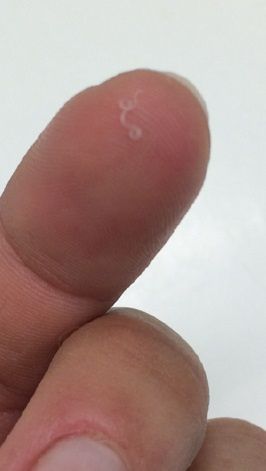
In February of 2018, a 68-year-old Nebraska woman was enjoying a routine trail run through the hills of California's Carmel Valley when she encountered a swarm of small flies. At the time, however, the occurrence did not seem to be anything extraordinary, but a month later, the lady began to feel some kind of irritation in her right eye.In an attempt to remove whatever foreign object that may be causing the irritation with tap water, the lady managed to flush out a small, transparent worm that measured about half an inch in length. Upon further inspection, she was able to remove the second motile ringworm from her eye, as well. The following day she went to see an ophthalmologist, who found and extracted the third ringworm from the lady's eye and gave her an antibiotic ointment to mitigate any possible bacterial infections.

After arriving back home in Nebraska, the mild irritation continued. She once again visited an ophthalmologist, where she was diagnosed with mild bilateral papillary conjunctivitis. No ringworms were detected at the time of her doctor visit.
However, she did discover and remove a fourth and final nematode soon thereafter, and her conjunctivitis subsided.
While her ordeal was a grave one, she can consider herself somewhat lucky. In the only other known case of this rare infection, a 26-year-old female patient extracted 14 worms from her eyes altogether. The two cases are less than two years apart.
After analysis of the worm taken from the Nebraska patient's eye proved to be Thelazia californiensis-a primarily veterinary infection and very similar to Thelazia gulosa-another horrifying discovery was made.
According to the recent case study published in Clinical Infectious Diseases, the worm was identified as an adult female and had laid eggs that contained "developed larvae" that were "in utero, indicating that humans are suitable hosts for the reproduction of T. gulosa."
Researchers strongly warn that if you feel any discomfort, or happen to discover worms in your eyes, to seek medical attention and have them removed as early as possible.
"In long-term untreated infections, chronic irritation caused by the passage of adult worms over the cornea may result in keratitis, loss of visual acuity, or even blindness," the research team stated.
In reported cases, if the ringworms were found and removed within the first couple of months, the chance of any long term clinical effects are very low.
As for now, scientists are not exactly sure how these women contracted the parasitic worms, however, a strong probability links the two cases. Most recorded instances of T. gulosa occur in cattle where the nematodes are almost always transmitted by flies and are introduced to the ocular region through tear ducts.

The lady from Nebraska clearly recalls running through a swarm of flies, as the authors noted in their study that she remembers "swatting the flies from her face and spitting them out of her mouth." While the initial case of the 26-year-old lady occurred after she had visited a farm and had gone horseback riding.
Although T. gulosa is common in livestock, there isn't any real system in place to monitor the spread of infection. Cases in animals have been found on nearly every continent, but scientists are not sure as to the reason for these recent interspecies infections.
"Monitoring of thelaziasis in cattle does not occur, and therefore it cannot be determined if there is an increasing prevalence of T. gulosa infections among domestic cattle which is resulting in zoonotic spillover events into humans and other unusual hosts," the authors explain.
The researchers conclude by stating that renewed surveillance studies on various mammals, such as cattle and deer, would assist in possibly determining areas and regions in the US that might be vulnerable to T. gulosa outbreaks.
© 2026 ScienceTimes.com All rights reserved. Do not reproduce without permission. The window to the world of Science Times.











